
“If the rate of change on the outside exceeds the rate of change on the inside, the end is near.” — Jack Welch
“Dad, if the Earth is moving around the sun, how do we not feel it?” asked my son.
It just so happened that we were on a train from Washington to New York. Earlier, he had thrown me something on the train. I used that example to explain that even though the train was moving at high speed he could still throw me something and we can still get up and walk around on the train. When everything moves at the same speed inside the train, then we can operate relatively normally. It does take a bit of adjustment, but we quickly adapt.
I used this example to then explain how we don’t really notice the movement of the Earth around the sun for the same reason (Earth rotates at about 1,000 miles per hour and orbits around the Sun at about 67,000 miles per hour). Everything on the Earth is moving in harmony.)
Corporate Trains
You can see where I am going with this.
So many organisations are massively out of sync with the external rate of change.
Many of you will recognise that you spend more time on internal meetings in order to make decisions rather than making any meaningful decisions.
Everything is internally focussed. Everything is focussed around maintaining things as they are and protecting existing revenue streams, existing product lines and existing modus operandi.
Too focused
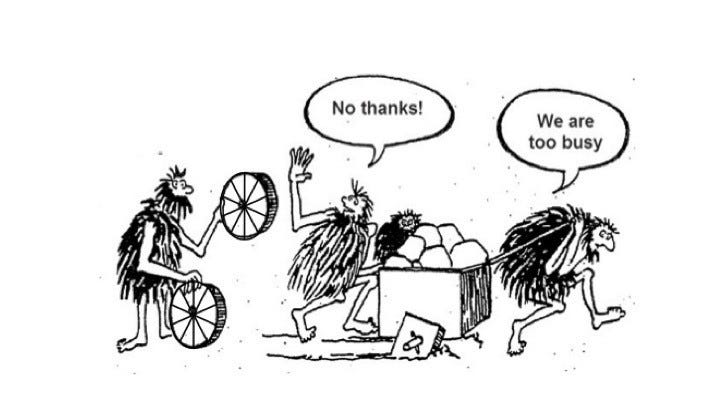
The more expert we become in our roles, the more we overlook (purposefully or otherwise) valuable information. Many organisations become ultra focussed on execution at the expense of strategy. Companies know how to do things, but rarely do they know why they do what they do.
Very few organisations step back to question if they are executing the right things.
Even fewer step back to question the insights that have formed the foundation of their strategy.
Fewer again question if their strategy is even a strategy or is it just a planning document.
The companies who live in Day One (In Startup Mode like Amazon) constantly survey their ecosystem, constantly survey what is going on outside their businesses and thus are not taken by “surprise” disruption.
“S”peed Curves
I wrote about S Curves a couple of weeks back, but here is a quick reminder.
S curves can map business and product life-cycles. S curves follow the shape of the letter S with a shallow start with early adopters and niche clientele. Rapid growth comes next, followed by a dominant position in the market.
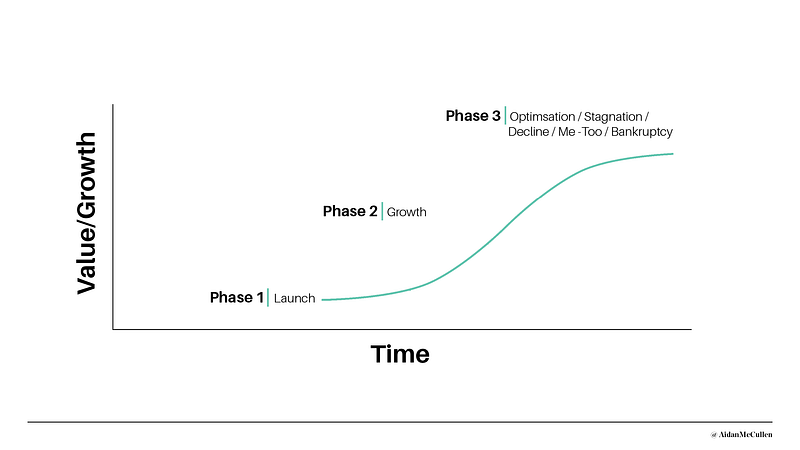
After the rapid growth, businesses or products plateau and experience stagnation, process optimization, automation job cuts and quite often a “me-too” proposition.
This is when the business is great at doing what they do. This often comes at the expense of looking beyond what they do.
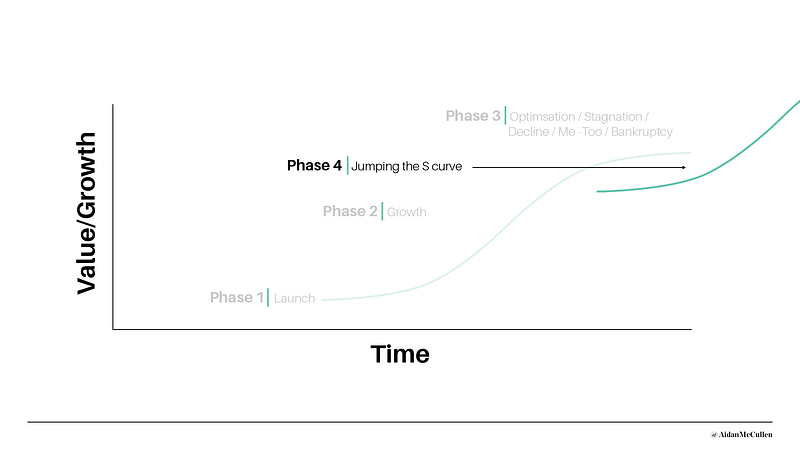
To truly innovate Companies and Leaders need to jump from one S curve to the next, but few have the courage to do so. The jump always looks like a step backwards, unless you have a leader who embraces the constant S curve mentality.
This jump often means jumping to a curve that does not have a proven revenue stream. This is why we see disruption coming from outside an industry. In turn, this is because startups cannot compete with business behemoths using the same rules, they need to innovate with business models, with regulations and with routes to market.
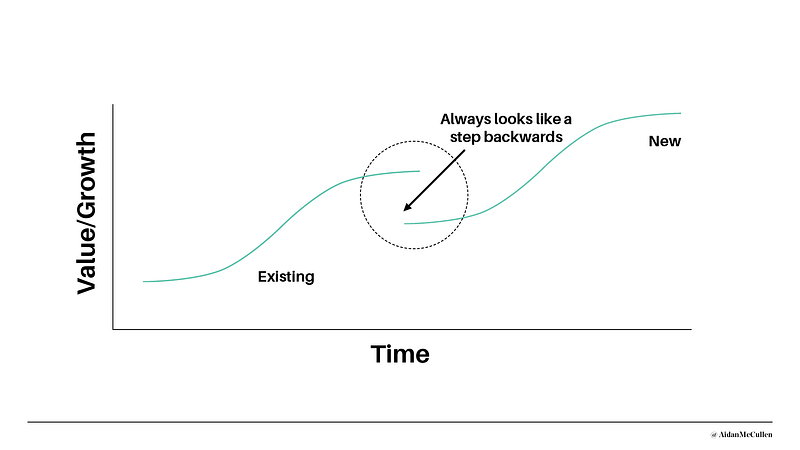
The Fallen/Falling Ones
Netflix
When Blockbuster CEO, Jim Keyes took over he ignored the speed of the outside world. From Keyes perspective, he was doing a good job focussing on what Blockbuster did well today and felt looking at the next jump (which looks like a step back) was a distraction.
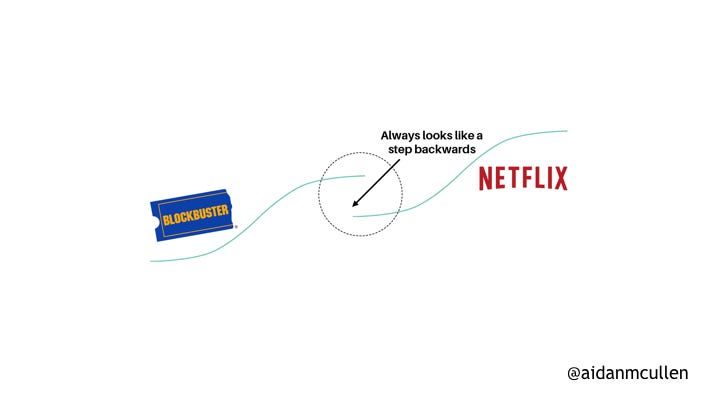
When quizzed over why he turned down the option to acquire Netflix he stated: (for under 1 million dollars) “Neither RedBox nor Netflix are even on the radar screen in terms of competition”. Not long after Blockbuster went bankrupt and we know the success story Netflix is today.
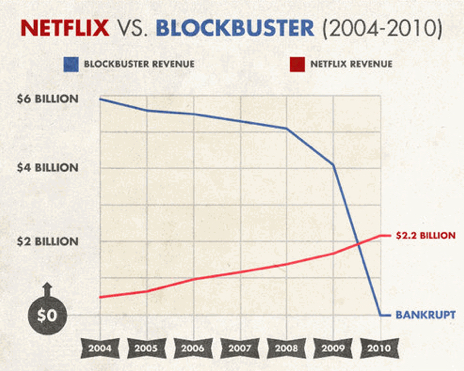
Media
Many people who worked in digital media/digital sales starting will have experienced huge resistance. The organisation made its money from traditional media, its current “S” curve and more than this everyone (except the people in digital) were incentivised on the performance of that first “S” curve.
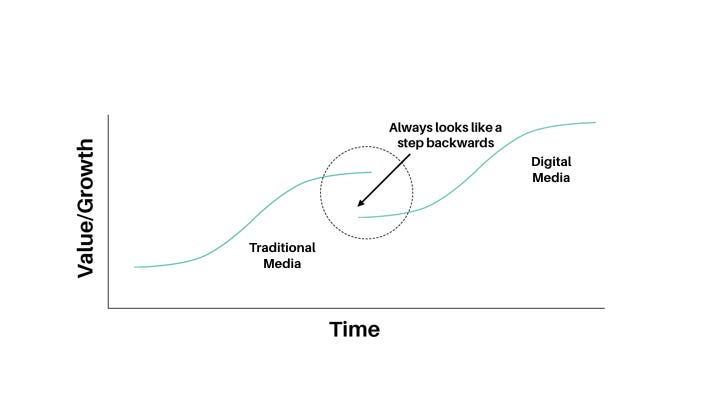
The biggest challenge was proving that the organisation needed to adapt to the speed of change on the outside. So many burgeoning talents in digital media jumped up and down and proclaimed the end was nigh like digital chicken littles. The chicken littles looked on as their ideas to build a better digital presence was ignored while pure-play digital content providers disrupted many traditional media giants. Then those chicken littles left and joined the pure players or tech companies like Facebook or Google.
Traditional media companies bundled digital with traditional advertising to maintain sales (bear in mind this was a perfect storm as this transition happened in the heart of the financial crisis). Meanwhile, digital-first media companies were adaptive to changing client needs and adapted to a world of solution sales.
It seemed like the bottom fell out of the market all of a sudden, just like it did with Blockbuster. The reality is this happened long before with the failure to make long-term decisions.

Amazon V Retail
“Staying in Day 1 requires you to experiment patiently, accept failures, plant seeds, protect saplings, and double down when you see customer delight. A customer-obsessed culture best creates the conditions where all of that can happen.” — Jeff Bezos
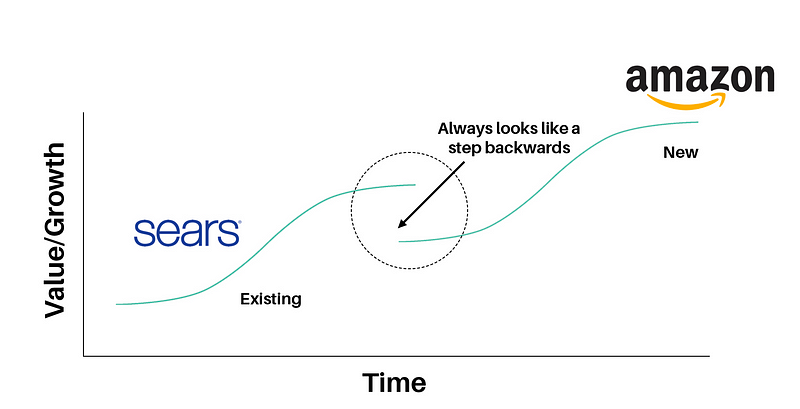
In the context of S curves, Bezos is referring to maintaining the mindset of an S curve jump. More importantly, he is referring to the avoidance of the dreaded plateau stage, where companies usually reside for some time before eventual bankruptcy or acquisition by a more strategic company or vulture fund.
Bezos refers to the top of the “S” stage as Day 2.
Here is how he describes Day 2:
“Day 2 is stasis. Followed by irrelevance. Followed by excruciating, painful decline. Followed by death.” — Jeff Bezos
While Bezos has progressed much of the business to Day 2, he simultaneously regenerates those businesses with constant Day 1’s. This is one of the cores of regenerative managingthat this week’s guest on the Innovation Show Joe Pine is working on with Kim Korn.
We have witnessed huge disruption (or death) with companies like Nokia, Blockbuster and Kodak and with industries like Financial Services, Media and Telecoms. Retail is in the top 4 most disrupted industries.
Retail, like most disrupted industries, ignored the speed of change until it was too late. As is the case with most disruptions, leadership had a short-term focus. Short term monthly, quarterly and yearly targets changes behaviours. This is most apparent in companies where the founder is no longer in the company or the company has been taken over by the shareholders or investors.
In such cases, decisions are made differently, the focus becomes the shortest route to return on investment rather than the best thing for the company and its customers.
When companies are already making money, they cannot shift the paradigm to see a new model. When people within those companies fail to get buy-in for new initiatives, they leave and so do the seeds of change.
If you look at the graph below, you will see the great long-term thinking of Amazon and how profit is thrown back into the company to ensure the lowest prices and biggest opportunity for success possible. As a result, Amazon will outlast the competition and continually adapt to the needs of the market.
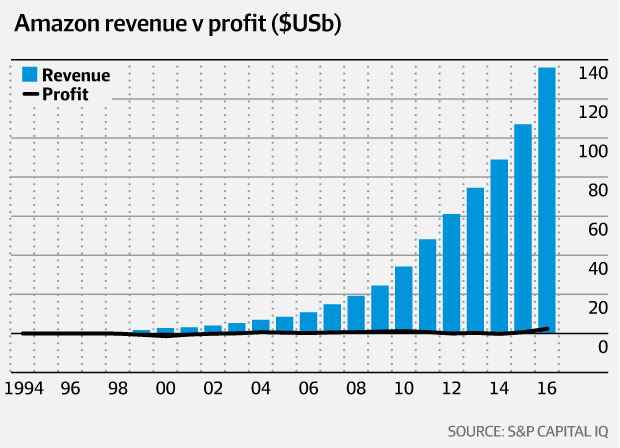
“If we think long term we can accomplish things that we wouldn’t otherwise accomplish. Time horizons matter. They matter a lot.” — Jeff Bezos
People may argue that Amazon is backed by cheap capital, but all the corporate powerhouses were at some stage making huge revenue. The temptation to bag that short-term revenue is indeed great, but to remain in “Day One” and not fall prey to disruption we must reinvest in the next curve.
The next chart speaks for itself.
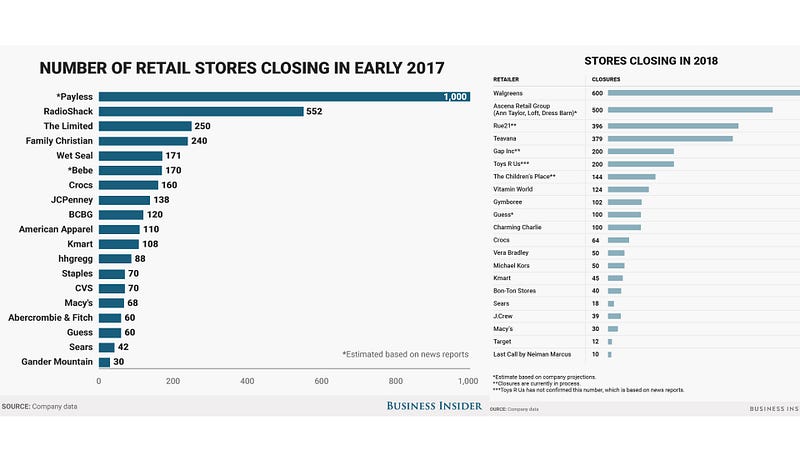
We must Thrive on Change
Jumping to your next curve while maintaining the current curve is difficult and needs to be embedded in an organisational culture.
Clayton Christensen explains this in his must-read ‘The Innovators Dilemma’. He explains that once-great companies fail because they do not embrace external evolving conditions such as technological advancements.
Steve Kessel was the Amazon executive who developed Amazon’s paper book distribution. Kessel was famously told by Jeff Bezos “Your job is to kill your own business… I want you to proceed as if your goal is to put everyone selling physical books out of a job.” Thanks to this North Star directive the e-book industry, the Kindle and a new Amazon revenue stream was born.
It is a case of “killing off” your former self or at least “managing the decline” of an outdated business (model) while building a new disruptive one. (This is the case for us in life also as covered in a previous Thursday Thought.)
Technology is not to blame as many people claim it is. Technology has just enabled the birth of new business models and the demise of old ones.
- Netflix did not kill Blockbuster. Ridiculous late fees and failing to acknowledge the next S curve jump “DID!”
- Technology is not killing Media. Failure to acknowledge the next S curve jump, failure to change mindsets and bundling digital for free “IS!”
- Amazon is not killing other retailers. Poor customer service, slow reactions to shifting human needs and failing to jump to the next S curve jump “WILL?”
The biggest difficulty as always is letting go of old ways of thinking, of status quo and of a sense of entitlement.
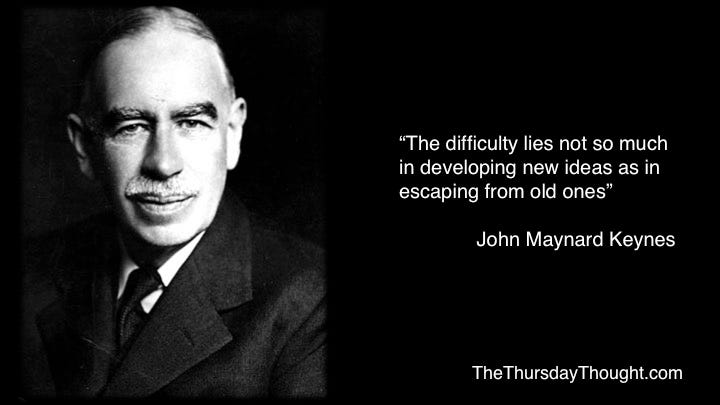
Many of us are tired of the mantra that disruption is all around us. However, relentless acceleration of change means we have to listen and we have to adapt, whatever our business or our roles.
The reality is we are hurtling into a future that will soon be very different and change is inevitable.
“It is change, continuing change, inevitable change, that is the dominant factor in society today. No sensible decision can be made any longer without taking into account not only the world as it is, but the world as it will be.” Isaac Asimov
Our guest on this week’s innovation show is the internationally acclaimed author, speaker, and management advisor to Fortune 500 companies and entrepreneurial start-ups alike B. Joseph Pine II.
Joe has been offering solutions to disruption for decades. His 1998 essential read is “The Experience Economy”, it is a guidebook on how to navigate change. Despite this book being around and despite Joe’s company strategic horizons offering solutions to disrupted industries they failed to embrace change.
Joe has long lamented that the industry that has needed to embrace the Experience Economy more than any other is the one industry that has rarely hired him: retail. You can see his thoughts on retail here.
Joe tells us on the show:
“For leaders looking at innovation, do not practice best-practices, that is just copying others, but embrace best principles.” — B. Joseph Pine II
You can listen to EP 82: What is The Experience Economy? with business provocateur Joseph Pine II at the links below:
Website: http://bit.ly/2FwsOJw
Spotify: http://spoti.fi/2rXnAF4
iTunes: https://apple.co/2gFvFbO
Soundcloud: http://bit.ly/2DZ1GpA
Tunein: http://bit.ly/2rRwDad
iHeart Radio: http://bit.ly/2E4fhfl
Subscribe by email: http://bit.ly/2EojOH7